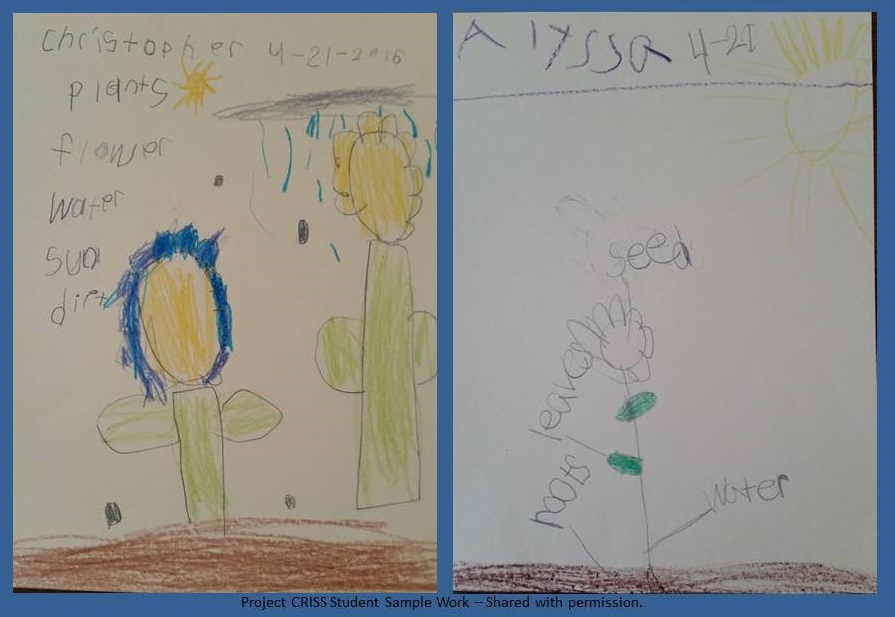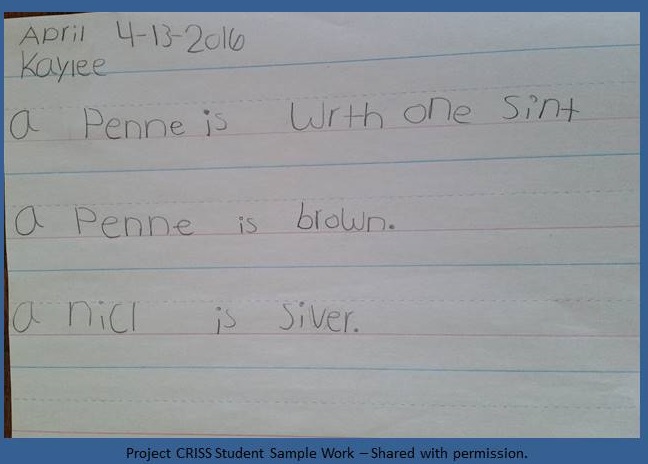Stell Chen, a District Trainer out of Cleveland ISD in Texas, recently shared several lessons from her Kindergarten classroom.
 In one lesson, the class was exploring the basic needs of plants and used Eric Carle's book The Tiny Seed. Throughout the lesson, Ms. Chen would ask guiding questions to help develop the content and address misconceptions. They collected information about what plants have, need, and give on a chart as a class.
In one lesson, the class was exploring the basic needs of plants and used Eric Carle's book The Tiny Seed. Throughout the lesson, Ms. Chen would ask guiding questions to help develop the content and address misconceptions. They collected information about what plants have, need, and give on a chart as a class.
Ms. Chen then said, To close the lesson, I had the students create their own Picture Notes about the basic needs of a plant. When I asked students how they knew to draw the plant that way or how they knew what descriptions they needed to include in their picture notes, many students mentioned that they were drawing their plant just like the one they remembered in the book and they were using the anchor chart to help them spell the words on their paper.
In the other lesson, students were learning all about coins. They used a KWL chart throughout but at the end, students wrote One-Sentence Summaries. Before the students were given the task to write their one-sentence summaries, each group was given a bag of coins to look at together. They were given an opportunity to discuss the attributes for a penny, nickel, dime and quarter. Once the students were able to talk in their group about the different coins, we came back together as a whole class to discuss what we noticed about each coin. We wrote those attributes on the board. I then modeled how to create a one-sentence summary using the ideas and words we had written on the board. I had written, “Coins have a head and a tail.” Since this seemed a little challenging to students to have to come up with a sentence that summarized all the coins we learned, I had them focus on one coin, the penny.
 I asked Ms. Chen what questions she asked her students about HOW they learned to help build metacognition in this young age group and she said that she was constantly asking students to justfify their questions. For example, she'd ask, "How do you know that?", "What made you think that?", or "What helped you come up with that answer?". Students would respond by saying they looked at a coin, heard it from a partner, found a crayon that was the same color, remembered a video, etc.
I asked Ms. Chen what questions she asked her students about HOW they learned to help build metacognition in this young age group and she said that she was constantly asking students to justfify their questions. For example, she'd ask, "How do you know that?", "What made you think that?", or "What helped you come up with that answer?". Students would respond by saying they looked at a coin, heard it from a partner, found a crayon that was the same color, remembered a video, etc.
In the CRISS office, we're often asked how to apply CRISS down to the youngest age levels. And the answer is scale: Simplify the questions, work in groups, and use manipulatives or kinesthetic activities during reflections (i.e., "Move to the corner labeled with the activity that you think helped you learn the most." or "Look at the pictures in front of you: A book, partners talking, crayons for drawing. Pick which activity helped you learn the most.").
The Framework for Learning applies whether you're pre-K or well out of college: There are always things we do to Prepare for learning, to Engage with new content, to Transform information in order to own it, and then we need to Reflect on what worked and what didn't. In a high school classroom, we may be working with dense chapters of a textbook while in pre-K we're talking about very hungry catepillars but the Framework is still there. It's just good teaching.
Thank you, Ms. Chen, for for showing us quick and easy ways to incorporate metacognitive growth in your kindergarten classrom!
Want to discuss this? Contact us at info@projectcriss.com or tweet your comment to us @ProjectCRISS. We'll add comments here!
